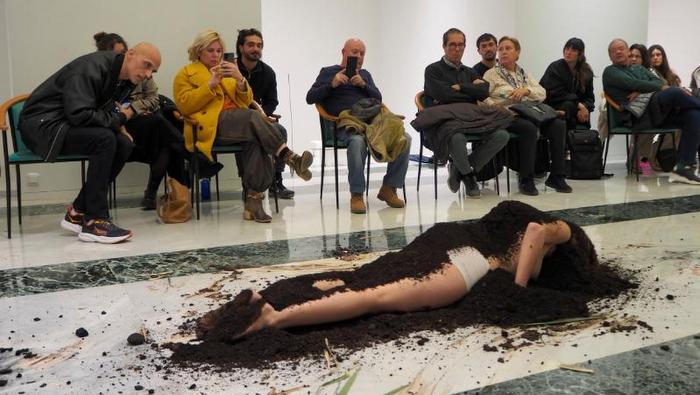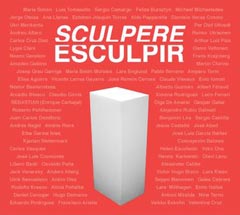
“Salvador Allende” Museum of Solidarity kicked off this year’s program with the inauguration of Sculpere-Esculpir. Forma, volumen y espacio: poéticas de la materialidad (Sculpt. Shape, volume and space: poetics of materiality).
“Grynna”, installation by Swedish artist Lars Kleen, monumental ship aground in the hall of the institution, welcomes those who visit this display of world sculpture with 92 works made during the second half of 20th century.
Sculpere-Esculpir. Forma, volumen y espacio: poéticas de la materialidadis a one-of-a-kind exhibition in Chile, as it gathers the widest range of trends adopted by this discipline with the emergency of art vanguards in the last century, expressed by outstanding international authors such as Lygia Clark, Alexander Calder, Carlos Cruz Diez, Yoko Ono and Daniel Canogar, among other.
It’s a life-time opportunity to admire, in only one tour, the aesthetics playing the leading role in the last century’s sculptural scene, which had a significant influence on today’s trends and derivations. That’s the reason why Sculpere-Esculpir… represents an excellent tool for visual art professors.
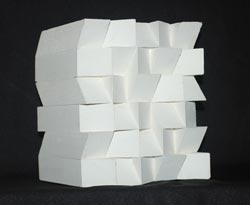 Salvador Allende Solidarity Museum –headed by Ernesto Ottone in this new stage– opens its doors to showcase some 40 sculptural works. All of them are part of MSSA collection, the biggest in Chile on international 20th century art. Most of these works were donated by artists from different countries in order to assemble the project, named Museum of Resistance (1973-1989), which symbolizes the cultural world solidarity against the cruel dictatorship in Chile.
Salvador Allende Solidarity Museum –headed by Ernesto Ottone in this new stage– opens its doors to showcase some 40 sculptural works. All of them are part of MSSA collection, the biggest in Chile on international 20th century art. Most of these works were donated by artists from different countries in order to assemble the project, named Museum of Resistance (1973-1989), which symbolizes the cultural world solidarity against the cruel dictatorship in Chile.
The selection of works has been organized into two theme axis, defined by the clash between Figuration and Abstraction. The abstract works were classified in two strong trends: geometric abstraction, represented, among other, by Venezuelan Carlos Cruz Diez, Brazilian Sergio Camargo and Ligia Clark and Argentine Hugo Demarco, in three halls of the museum.
In the second floor, distant works will be exposed grouped in terms of language and year, framed within informal abstraction (or informalism). This trend emerged as respond to the control and precision of geometric ideal, proposing the individualism and expressive spontaneity of matter and gesture. We’ll see, among other, works of Spanish Pablo Serrano and Martin Chirino, French Claude Viseaux, Argentine Ennio Iommi, Chilean Sergio Castillo, Gaspar Galaz and Elisa Aguirre and Argentine based in Chile, Claudio Girola.
On the other hand, figurative trends will take three walls in the museum, classified in sculptural works where the objet appropriation prevails, works expressing a prolongation of pop art (American) and the new realism (European), and other incorporating the participation of spectators.
Argentine artist Leon Ferrari will play a leading role in one hall, with his female mannequin carrying brilliantine, religious illustrations, images of art history and handwritten texts. This author is famous due to his radical denunciation on the mechanisms of fascism and religion.
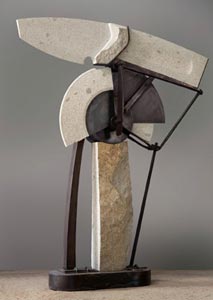 The object aspect will be represented, among other, by Swedish Kjartan Slettermark, Argentine Juan Carlos Distefano and Spanish Jose Luis Coomonte. In the second hall, the work of Swedish Anders Aberg will share room with Chilean Osvaldo Peña and Victor Hugo Bravo, Mexican Helen Escobedo and Argentine Jack Vanarsky, all of them with winks at Pop Art.
The object aspect will be represented, among other, by Swedish Kjartan Slettermark, Argentine Juan Carlos Distefano and Spanish Jose Luis Coomonte. In the second hall, the work of Swedish Anders Aberg will share room with Chilean Osvaldo Peña and Victor Hugo Bravo, Mexican Helen Escobedo and Argentine Jack Vanarsky, all of them with winks at Pop Art.
The third hall, dedicated to figuration, will house different works that have the same conceptual character and the incorporation of spectators in their meaning. A part of “Play it by trust” installation is included among these, donated to the MSSA by Yoko Ono, the famous Japanese artist, widow of John Lennon. Showcased in London back in 1966, the work includes tables and chairs inspired in the furniture created by Viennese architect and designer from the early 20th century, Josef Hoffmann. The pieces are painted in white, and there is a chess board on the base of the table, with squares differenced by their height. In the same room, there’ll be a sculpture of Swedish artist Lars Millhagen and Argentine Rodolfo Krasno. There’s also a hall dedicated at Spanish Daniel Canogar’s work, where virtual volume is achieved through the projection in optic fiber.
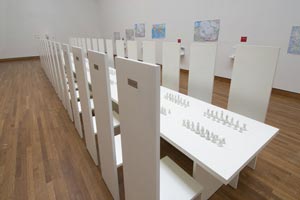 Sculpere-Esculpir. Forma, volumen y espacio: poéticas de la materialidad is the first sculpture exhibition carried out by the MSSA. That’s the reason why some of the works passed a strict restoration process, in some cases –just like in kinetic art works– updating the devices used. The display will transform the museum into a huge sculptural container, inviting people to know, discover and reflect on the preoccupations faced by artists regarding to space and tri-dimensionality.
Sculpere-Esculpir. Forma, volumen y espacio: poéticas de la materialidad is the first sculpture exhibition carried out by the MSSA. That’s the reason why some of the works passed a strict restoration process, in some cases –just like in kinetic art works– updating the devices used. The display will transform the museum into a huge sculptural container, inviting people to know, discover and reflect on the preoccupations faced by artists regarding to space and tri-dimensionality.
The “Sculpere-Esculpir. Forma, volumen y espacio. Poéticas de la materialidad” exhibition will be available through July 5 at Salvador Allende Museum of Solidarity (Av. Republica 475, Metro Toesca o Republica).
Source: Note sent to our office by Chilean journalist Elisa Cardenas


